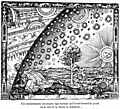پەڕگە:Flammarion.jpg

قەبارەی ئەم پێشبینینە: ٧١٦ لە ٦٠٠ پیکسەڵ. ڕێزەلووشنەکانی تر: ٢٨٧ لە ٢٤٠ پیکسەڵ | ٥٧٣ لە ٤٨٠ پیکسەڵ | ٩١٧ لە ٧٦٨ پیکسەڵ | ١٬٢٢٣ لە ١٬٠٢٤ پیکسەڵ | ٢٬٤٤٥ لە ٢٬٠٤٨ پیکسەڵ | ٣٬٦١٤ لە ٣٬٠٢٧ پیکسەڵ.
پەڕگەی سەرەکی (٣٬٦١٤ × ٣٬٠٢٧ پیکسڵ، قەبارەی پەڕگە: ٣٫٧٨ مێگابایت، جۆری ئێم ئای ئێم ئی: image/jpeg)
مێژووی پەڕگە
کرتە بکە لەسەر یەکێک لە ڕێکەوت/کاتەکان بۆ بینینی پەڕگەکە بەو شێوەی لەو کاتەدا بووە.
| ڕێکەوت/کات | ھێما | ئەندازە | بەکارھێنەر | تێبینی | |
|---|---|---|---|---|---|
| هەنووکە | ١٦:٠٥، ٣ی تەممووزی ٢٠٢٠ |  | ٣٬٦١٤ لە ٣٬٠٢٧ (٣٫٧٨ مێگابایت) | Sette-quattro | Higher quality image, adapted from https://commons.wikimedia.org/wiki/File:Un_missionnaire_du_moyen_%C3%A2ge_raconte_qu%27il_avait_trouv%C3%A9_le_point_o%C3%B9_le_ciel_et_la_Terre_se_touchent_..._LCCN95502287.jpg Edits: - sharpened the original scan - cropped |
| ٠٨:٢٤، ١٠ی تشرینی دووەمی ٢٠١٠ |  | ٣٬٠٠٠ لە ٢٬٥٠٠ (٢٫٩٢ مێگابایت) | Kugland | Now ’tis better, uh? | |
| ١٧:٠٧، ١١ی کانوونی دووەمی ٢٠٠٦ |  | ١٬١٥٧ لە ١٬٠٤٦ (٧٠٣ کیلۆبایت) | Leinad-Z~commonswiki | larger version | |
| ١٢:٤٢، ١٠ی ئەیلوولی ٢٠٠٥ |  | ٥٠٠ لە ٤٥٤ (١١٥ کیلۆبایت) | Dbachmann | Camille Flammarion, L'Atmosphere: Météorologie Populaire (Paris, 1888), p. 163. http://en.wikipedia.org/w/index.php?title=Flat_Earth&action=edit§ion=4 the History of Science Collections, University of Oklahoma Libraries allows educational reproduc |
بەکارھێنانی پەڕگە
ھیچ پەڕەیەک نییە کە ئەم پەڕگەیە بەکاربھێنێت.
بەکارھێنانی سەرانسەریی پەڕگە
ئەم ویکیانەی دیکەی خوارەوەش ئەم پەڕگە بەکاردێنن:
- بەکارھێنان لە af.wikipedia.org
- بەکارھێنان لە ar.wikipedia.org
- بەکارھێنان لە ca.wikipedia.org
- بەکارھێنان لە cs.wikipedia.org
- بەکارھێنان لە de.wikipedia.org
- Astronomie
- Diskussion:Astrologie/Archiv/002
- Neugier
- Camille Flammarion
- Flache Erde
- Diskussion:Kopernikanische Wende
- Flammarions Holzstich
- Erkenntnistheorie
- Benutzer:Redwoodseed
- Benutzer:Someone25
- Benutzer:Doket
- Benutzer:KasparSturm
- Benutzer:JoKalliauer
- Benutzer:JoKalliauer/Babel
- Benutzer:AdAstraPerScientiam
- Benutzerin:Tetraeder
- Geschichte der Naturwissenschaften
- Benutzer:Josef2610
- Benutzer:Christian Ude
- Diskussion:Kopernikanische Wende/Archiv 1
- Wikipedia:Auskunft/Archiv/2012/Woche 31
- Benutzer:AdAstraPerScientiam/Vorlagen
- Benutzer:AdAstraPerScientiam/Vorlagen/Benutzer-Naturwissenschaftler
- Benutzer:Ramses303
- Benutzer:MatWiss
- Benutzer:Zerogs777
- Benutzer:ASGSPEZ Webteam
- Benutzer:Ralph Reichelt
- Benutzer:Peter ihm sein Knie
- Benutzer:Merksatz
- Benutzer:AllIC
- Benutzer:Tolgato93
- Wikipedia:Auskunft/Archiv/2017/Woche 14
- Benutzer Diskussion:Olaf Studt/Archiv 2016
- Benutzer:Nichu42
- Benutzer:Mirabella
- Benutzer:FelixSev
- Benutzer:Headbugle
- Wikipedia Diskussion:Kurier/Archiv/2023/10
- بەکارھێنان لە de.wikiversity.org
- بەکارھێنان لە el.wikipedia.org
بینینی بەکارھێنانی گشتی زیاتری ئەم پەڕگەیە.






